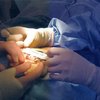The menisci are two pieces of C-shaped cartilage that form a buffer between the tibia and femur bones in the knee. The medial meniscus, on the inside of the knee, provides joint stability and extension, acts as a shock absorber and aids in joint lubrication. The most common causes of meniscal tears are over-flexing or twisting of the knee joint. The symptoms of a medial meniscus tear are knee pain, locking of the knee joint and recurrent knee-catching.
Non-surgical Treatment
Non-surgical treatments reduce symptoms and protect the joint from further injury. Use crutches to avoid putting your full weight on the knee. Wear a knee brace or wrap to prevent further injury. Using an ice pack reduces inflammation and swelling. Nonsteroidal anti-inflammatory drugs (NSAIDS) decrease pain and swelling. Limit physical activity so tissue near the injury has time to heal. Physical therapy helps you to regain leg and joint strength. Ultrasound, transcutaneous electrical nerve stimulation (TENS), electrotherapy, and massage reduce pain and inflammation, and speed the healing of small tears.
Surgery
A partial meniscectomy is a surgical procedure that removes only the torn section of the meniscus. The location of the tear is a limiting factor. The orthopedic surgeon usually performs arthroscopy, an examination and repair procedure for the inside of a joint, by inserting a thin tube housing a camera (arthroscope) into a small incision near the joint. Surgical instruments are inserted through other small incisions to remove meniscal fragments and to smooth frayed edges. The age of the patient, location of the tear and overall patient’s health are factors the orthopedic surgeon must consider. Surgeons usually try to avoid a total meniscectomy, removal of the entire meniscus, because of the increased risk for osteoarthritis.
Orthopedic surgeons may also repair the meniscus by opening up the knee with an incision. The risks associated with surgery include infection, nerve damage, blood clots, joint damage and anesthesia complications.
Alternative Treatments
The meniscal welding technique uses laser beams to remove menisci. Another procedure, partial meniscal replacement, uses a device designed to stimulate regeneration of meniscal tissue to replace damaged host material.
Rehabilitation
The age and health of the person, as well as their physical demands after knee surgery, are all factors considered in the rehabilitation process. Typically, surgery is followed by a rest period, walking and exercises. Many people who have arthroscopic surgery are able to bear weight one to two days after surgery. They may return to regular activities two to four weeks after surgery.
References
- "The Internet Journal of Orthopedic Surgery;" The Different Modalities of Treatment of Torn Meniscus; Cyril Mauffrey, MD, MRCS, SpR, and A. Prasthofer, SpR; 2006
- WebMD: Meniscectomy for a Meniscus Tear
- "Journal of Bone and Joint Surgery;" Alternative Treatments for Meniscal Injuries; R. Verdonk; September 1997
Image Credit
knee X-ray image by JASON WINTER from Fotolia.com





